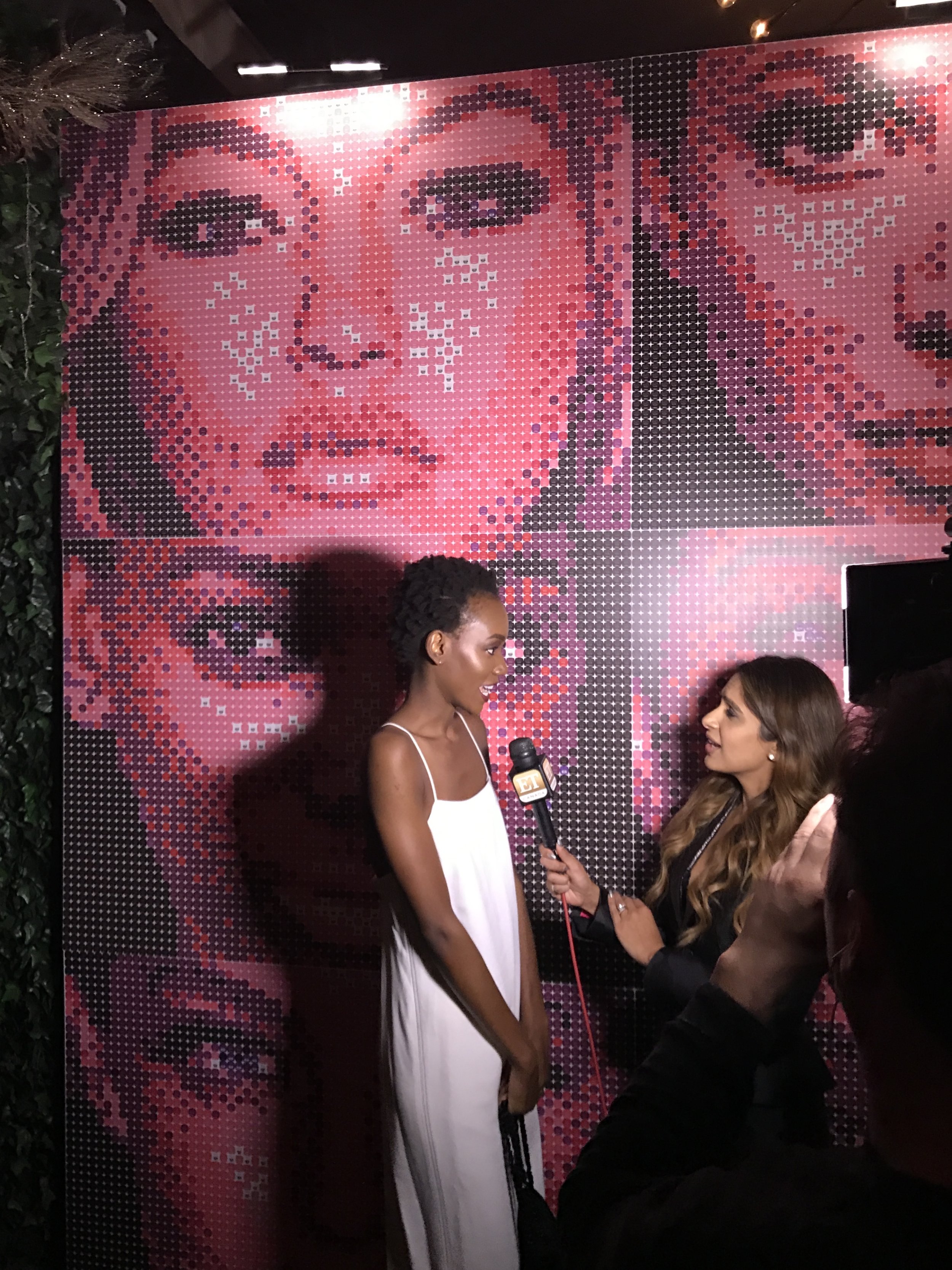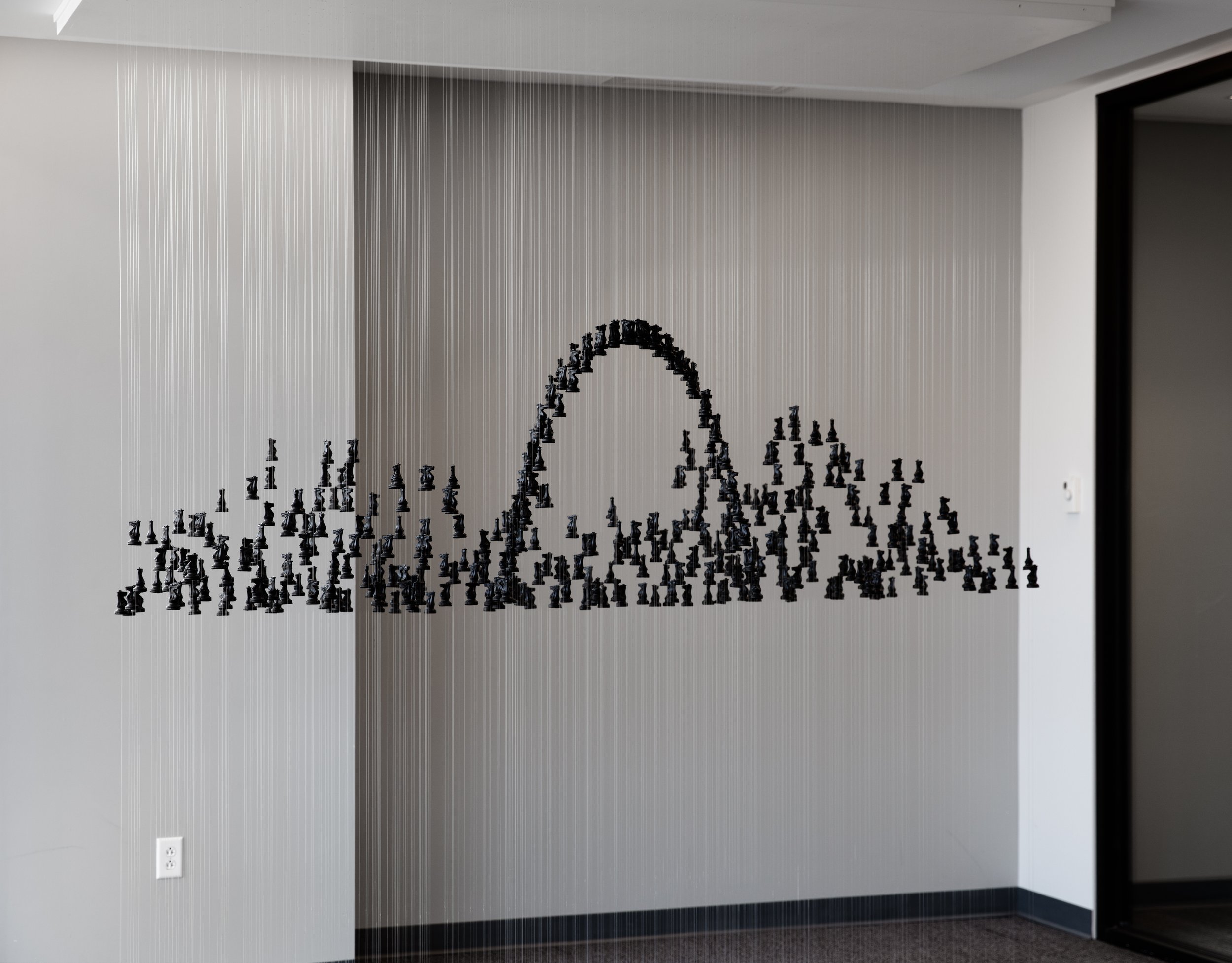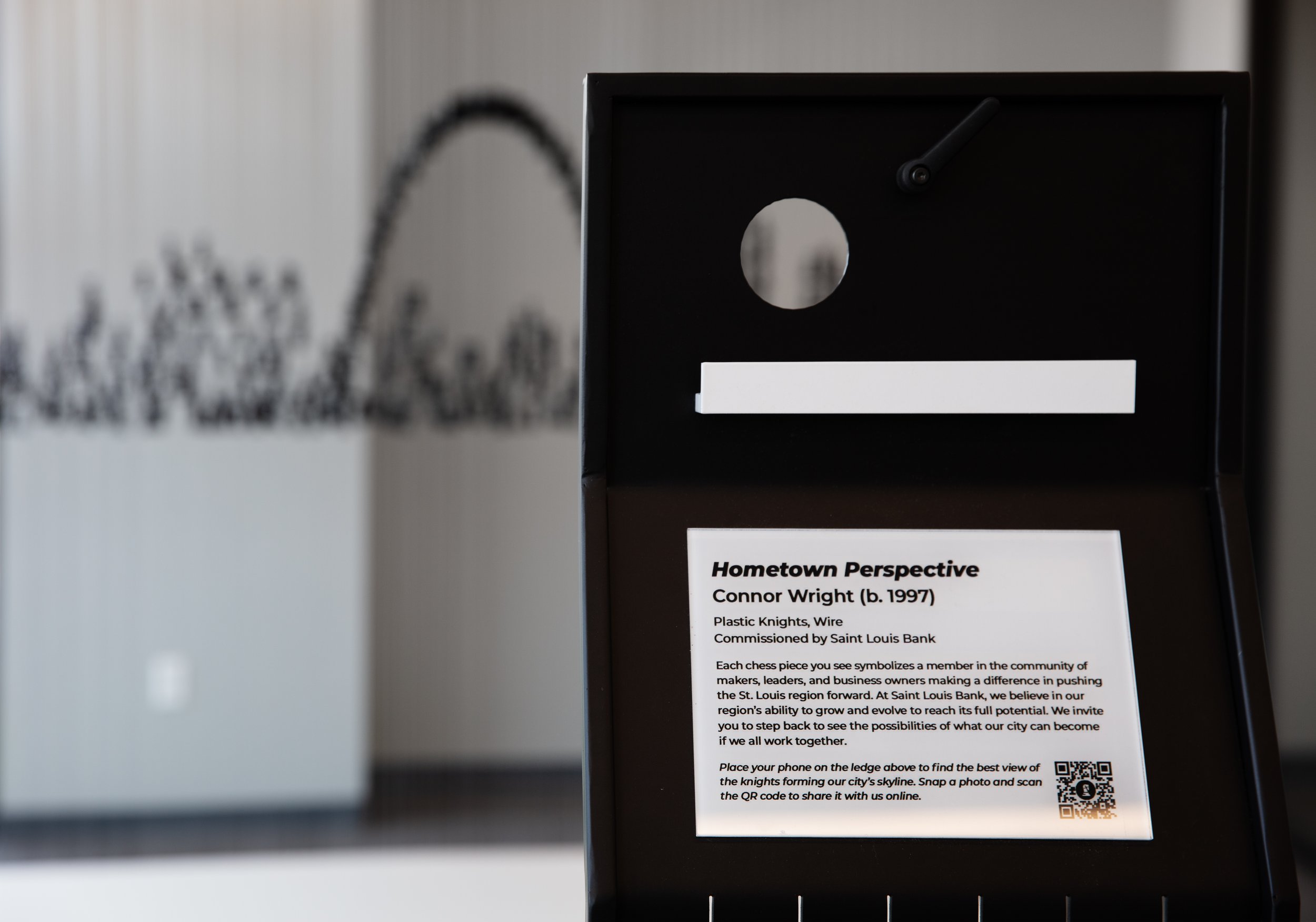The Message is the Medium: Anamorphic Sculpture
by Craig Kaminer, Photos by Carman Troesser, additional photos provided by Connor Wright
You may have seen the artwork of Connor Wright around St. Louis, or on the news, or in another city where he is making headlines. This 25-year-old artist from St. Louis attended Priory and graduated from the University of Pennsylvania with a degree in Cognitive Neuroscience, with an aptitude for math, algorithms and all things visual. With a wild imagination and the ability to take an idea – a big idea – and turn it into a 3D work of art, he is being sought by companies, cities, collectors, and the art world in general...and he is fetching top dollar for his work.
Connor Wright
His talent was noticed immediately and he received commissions for major installations from the Cardinals, The Magic House, Facebook, Maybelline, Saint Louis Bank, and now a Broadway production company to name just a few. Combining his raw genius with the ability to tell complex stories in visual terms, his career trajectory is what you would expect from a hot start-up company, not a conceptual artist.
Stan Musial mural made from Rubik’s Cubes at Ballpark Village.
“I grew up loving art and making it all the time,” he explained. “I recently found an assignment from first grade where I shared that I wanted to be the world’s most famous artist when I grew up. And I just thought it was so funny when I found it. I don't even remember writing that, but obviously I have felt connected to the process of creating art for as long as I can remember.”
By middle school, he was much more into math and science. But in an art history class in high school, he learned about pointillism and its relationship to math. A light bulb went off and he started to draw again. It was the perfect combination of his love for the freedom that art allows combined with the systematic nature of math.
“My high school senior thesis was a large pointillistic mural. Being obsessed with Rubik's Cubes for all of fifth and sixth grades, I decided to use planning systems and math to pay homage to Stan Musial. Why Stan Musial? He was always an inspiration for what it means to take what you're good at and give back as much as you can. I did a 200 square foot mural of him at Ballpark Village for the Cardinals made out of 5,980 Rubik’s Cubes. I started constructing it on the floor of our living room and my parents had to move the dining room table out of the house. Finally, after four or five months, I boxed up all the Rubik's Cubes in order, took them to Ballpark Village, and installed them one by one.
Closeup of Rubik’s Cubes used to make Stan Musial mural.
The news coverage of the mural prompted The Magic House to reach out to get their own Rubik’s Cube mural. “I met with The Magic House and told them that I didn't want to be the Rubik’s Cube guy; I wanted to push my talents by using a completely different medium. I decided on crayons - where you only see the bottoms of them. It was going to take 300,000 crayons to create a work large enough to fill the hallway where it would be installed. I reached out to 180 grade and middle schools across the area. The art teachers at those schools filled 132 boxes with 2,024 crayons each. I put together a demo video, put a sheet in the back of each box, and then sent them a Ziploc bag that contained the exact numbers of every shade necessary. In the end, there were 77 different shades of crayons used.” Wright acknowledges that it was quite a feat for him and The Magic House. “Even the CFO of The Magic House was on her hands and knees for five hours, sorting crayons with the rest of us, totally committed to making it all happen.”
St. Louis skyline installation at The Magic House.
Closeup of crayons used to make St. Louis skyline at The Magic House.
“Then the CFO of Facebook, Dave Wehner, who is a Priory alumnus, came back to speak at our father/son banquet. I was the student council president at the time and we were seated at the same table. We talked throughout the evening. By the end he invited me to come to Facebook headquarters that summer before I started college to do a mural there.”
The Facebook mural was of Alan Turing – the father of theoretical computer science – made from almost 10,000 dominoes. Not only was he the father of computer science, but an LGBTQ icon and a great source of inspiration for Wright personally. Like all of Wright’s art, there is always a rhyme to his reason. For the Alan Turing piece, it was the binary code that inspired Turing to create the computer. For Wright, dominoes were the perfect medium to represent that.
Alan Touring image in dominoes at Facebook headquarters, Photo provided by Connor Wright.
“I did not know exactly what I wanted to create until 10 days before the end of my residency at Facebook. I had to launch into gear. I bought 10,000 dominoes from a little toy shop - which doubled their domino orders for the entire year. I only needed certain dominos for the mural so the Facebook CFO and his family helped me sort them for hours.
Two months into school at Penn, Wright woke up to 100 text messages telling him to check out his Instagram page. Mark Zuckerberg had posted a picture of his Alan Turing mural with a blurb saying that it was done by Connor Wright from St. Louis and that it was one of his favorite art pieces on the entire (Facebook) campus.
“I had been told that the artist residency program at Facebook allows the artist to choose any blank wall on the entire Facebook campus. I walked straight to Mark Zuckerberg's office and found the closest blank wall to it because I wanted it to be where the CEO walked every single morning. And sure enough, two months later the mural was on his Instagram.” After that, everything took off.
Wright was next contacted by Maybelline because they were the lead sponsor of New York Fashion Week that year. The company was launching a new lipstick and he was asked to create a mural featuring their nine spokesmodels - out of 10,000 lipstick labels from the new line. After Fashion Week, the models could take home their own portraits. Unfortunately, couriers dropped Gigi Hadid’s portrait when delivering it, ruining it. “She was so upset. I wanted to make it up to her so I remade the portrait and dropped it off to her the next morning. I just couldn’t pass up the chance to have my art in her home.”
Maybelline installation for New York Fashion Week, Photo provided by Connor Wright.
In 2020, just two weeks after graduating college and one week following George Floyd’s murder, Wright and his friend, Anna Barber, created the Say Their Names Cemetery in Minneapolis. It was conceived as a temporary cemetery memorializing Black lives lost at the hands of police. It was intended to be for two or three days. But, an angel on the board of public art in Minneapolis heard about it on the news and made sure that nobody in the city touched the installation. Almost three years later, it's still standing. “We had the idea on a Monday, flew to Minneapolis on Tuesday morning, got an Airbnb, and arranged 25 different volunteer groups of students that Wednesday and Thursday while we were sourcing the materials to build the headstones for the cemetery,” recounted Wright.
On Friday morning, all of the volunteers met at the Airbnb where Wright and Barber were storing all the materials. As luck would have it, there was a 10K march for Black Lives Matter, in protest of the murder of George Floyd, the same day. “As soon as the crowd saw the cemetery, walkers stopped and flooded into it. They all had a moment of remembrance. It was really moving but it was also really powerful to see that many people coming together.”
Word of the makeshift cemetery spread quickly and people came forward asking if their loved ones could be added to the cemetery. Wright quickly realized that this was not going to be a static installation for one weekend. They extended their stay at the Airbnb by over a month and worked every single day to add more temporary tombstones. By the end of the month, there were 160 tombstones. A week after installing it, it was on the front page of the New York Times.
The temporary cemetery, made only of corrugated plastic, still stands and is a place for families to grieve and for the community to come together.
“This project was extremely integral to my career as an artist because it allowed me to realize what drew me to art in the beginning, which is the power of storytelling through art. With a small idea and getting enough people on board, you can truly make a huge impact. With this installation, and then with the influence from Christo, Jeanne Claude, and Olafur Eliasson, it helped me unlock my potential as a conceptual artist, which isn't based on the medium, but is based on the message.”
Most recently, Wright completed an installation of the St. Louis skyline for Saint Louis Bank. It is made from 600 chess knights suspended from the ceiling. When you look at it straight on you realize it is the city of St. Louis. But when you walk by it, it changes and you can’t tell what it is. The chess pieces are a nod to the bank’s logo, a knight, and St. Louis’ important place in the chess world. But there's a lot deeper meaning as well. According to Wright, it is a tribute to the incredible strategy that has gone into developing St. Louis into what it is today. Saint Louis Bank wanted a way to somehow tie the city of St. Louis and everything that has been built with the individuals who have actually made that happen. “I suspended the pieces into a moving constellation representing imagination and brainstorming. As you walk by it for just a split second, everything comes together to remind us of what it took to make St. Louis the great city it has become.”
St. Louis skyline made out of chess pieces at Saint Louis Bank.
Closeup of chess pieces used in St. Louis mural.
Since finishing the Saint Louis Bank installation, Wright moved into a New York studio and started a commission from the Broadway production company which produced “Kinky Boots,” “Dear Evan Hansen,” and “Funny Girl.”
“In talking to this company, it was a no-brainer because they are allowing me to express my artistic vision in whatever way I want. And as my client, they are extremely open-minded to what I end up delivering. They have given me full creative control, which is rare in a commission.”
“Concurrently, I started developing a new series of 20 pieces. The medium and message will be revealed once they’re shown in New York, but for now the name is Weekend Away. In addition, I am working on a large-scale installation in New York with more details to come later this year. The medium is going to end up shifting as I explore this series.” Recently the CEO of the Pittsburgh airport reached out about potentially doing a large-scale installation there. ”I've got a lot going on, but I'm equally excited about all of them, and I just really can't wait to see how this next year unfolds.”
While Wright started out doing murals, don’t expect him to be limited by that type of installation. A whole new generation of hybrid artists are producing music, fine art, short films, and public installations. Wright is typical of this new generation and the new way of doing things. One thing is for certain, Wright is off to a very impressive start.









